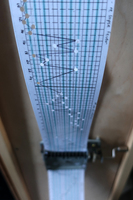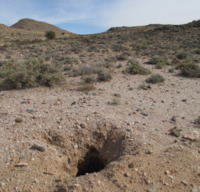Items
Site
The Medicine Chest
keywords is exactly
translation
-

Listen Laennec
"In this work, the temperature graphs of individuals suffering from malaria, yellow fever, trypanosomiasis and tickborne-relapse fever – all viewed as ‘tropical’ and treatable by the contents of the medicine chest – were converted into a musical score. I punched the strips of paper of a hand-cranked musical box mechanism with holes that corresponded to the graphs – the vertical axis representing temperature variations and the horizontal axis representing the approximate number of days the fever is said to last. The translation of these graphs into notes seems nonsensical, as we do not listen for a temperature; we measure it by feeling a forehead or taking a reading with a thermometer. The practice of listening has, however, been part of the history of medicine since the days of Hippocrates (c.460–c.370 BC), when physicians performed auscultations of the lung and heart by placing their ear directly on the patient’s chest' (Liebenberg 2021: 265). -

Page 81 of the Curiosity CLXXV catalogue.
"At the opening of the Archive and Archive and Public Culture programme (APC) in 2009, Prof. Ndebele stated that ‘there can be no transformation of the curriculum, or indeed of knowledge itself, without an interrogation of archive’, a call which both the Centre for Curating the Archive and the APC have sought to answer by producing scholarship that questions and expands what we understand as ‘archive’ and its relevance in a South African context and in an African university (Skotnes 2019: 21)" (Liebenberg 2021: 195). -

Silver Particle / Bronze (After Henry Moore).
"In Simon Starling’s work, inanimate objects are activated in various ways, especially when their political or economic history is revealed or when their materiality becomes an embodiment of something discovered during his research. His work enables and celebrates diverse interpretations of objects in many instances, as Greenblatt (1991) notes when referring to artistic and curatorial activity, deflecting attention away from the object onto the systems that gave rise to it in the first place. Starling conducts a close inspection of his objects, usually following a web of connections across the globe and across history, which in many of his works lead him back to the starting point; a vintage photograph of a Henry Moore sculpture leads to the production of a bronze sculpture based on the shape of a single enlarged silver particle that makes up the photograph and which, when converted into a sculpture, resembles the biomorphic shapes that served as inspiration for the Moore sculpture in the original vintage photograph ('Silver particle/bronze (after Henry Moore)', 2008). The machinations of its history somehow lost in the image when seen in the museum archive come back into play through the translations and reconstructions encountered in the detour and are materialised in the exhibition format" (Liebenberg 2021: 26 - 28). -

Vatnajökull (the sound of)
A live phone line was created to an Icelandic glacier, via an underwater microphone submerged in Jökulsárlón lagoon, an outlet of Vatnajökull. The number 07757001122 could be called from any telephone in the world, and the listener would hear the sound of the glacier melting. -

Perpetuum Mobile (2400KG)
Water, bucket, hydrophone, mist-machine, 2 400kg cement, relay timer, amplifier and cable. Water is set in motion by means of ultrasound (at times amplified by loudspeakers), generating steam that slowly spreads through the exhibition space and envelops sacks of cement whose mass is changed as the exhibition proceeds by the meandering atmospheric humidity. -

Years
“On regular vinyl, there is this groove that represents however long the track is. There’s a physical representation of the length of the audio track that’s imprinted on the record. The year rings are very similar because it takes a very long time to actually grow this structure because it depends on which record you put on of those I made. It’s usually 30 to 60 or 70 years in that amount of space. It was really interesting for me to have this visual representation of time and then translate it back into a song which it wouldn’t originally be " (Traubeck 2012). This record features seven recordings from different Austrian trees. They were generated on the Years installation in Vienna, January 2012. -

Holes
The landscape of the Karoo and the Northern Cape – the land of the |xam – is rich with holes in the ground. Below the surface of the earth burrowing animals navigate their way through the roots of grasses and shrubs, small trees and creepers. Holes are made and inhabited by scorpions and spiders, mice and shrews, suricats and mongooses. One of the most energetic of burrowers is the anteater whose holes, in places, transform the landscape. Anteaters are such active diggers and their holes so numerous that abandoned burrows are quickly occupied by bat-eared foxes, hyenas, hares, civets, bats, jackals, owls and porcupines (Skotnes 2010: 26) -

SP-368 Biomedical Results of Apollo
Electrocardiograph signal received at Mission Control during various periods of the Apollo 11 mission -

Resonance
Demonstration of sympathetic vibration using the optical (flame) microphone


